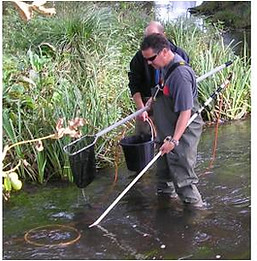Water-related Services
Effects of terrestrial land use and freshwater biodiversity
on fish production and water quality
This work package is led by Iwan Jones at Queen Mary’s
College University of London. It addresses the role of
aquatic biodiversity on delivering ecosystem services
of fish production (primarily for recreational angling)
and water quality.
The following hypotheses will be tested:
H1. Higher macro-consumer trophic diversity will increase resilience in the delivery of ecosystem services.
H2. Driver-pressure gradients associated with declines in biodiversity in the catchment will result in declines in the delivery of ecosystem services in rivers.
H3. Methods developed to assess water quality using biota (e.g. RIVPACS) are suitable indicators of ecosystem service delivery.
The work package involves a large-scale survey relating agricultural intensity in catchments to freshwater foodwebs and water quality. At three sites intensive sampling will be used to create local food webs detailing the flux of mass and C, N and P between the nodes of the web. Food web models will be used to understand the flux of the elements C, N and P between the nodes of the food web and, thus, relate to the ecosystem services of fisheries (particularly of salmonids), and the retention and cycling of nutrients. In addition, models will be interrogated by sequentially removing species (with known sensitivities to catchment scale drivers-pressures) to detect resilience and any thresholds in ecosystem service delivery.
Monitoring methods to assess biomass and nutrient processing of invertebrates, detritus, periphyton and fish (non-lethal) sampling




Latest Updates

freshwater shrimp
A sample of Gammarus pulex ground to a powder and ready for elemental analysis.
Initial results have found that across the three streams, which span a gradient of catchment land-use intensity, there is variation in the range of basal resources consumed, trophic diversity, and extent of niche packing of species.

Quantifying the food webs
Freshwater biologists at Queen Mary University of London have been busy in the laboratory processing the many samples.
Gut contents flushed from a brown trout captured in the River Wylye. The trout had recently eaten some freshwater shrimp, caddis flies, leeches and worms.
